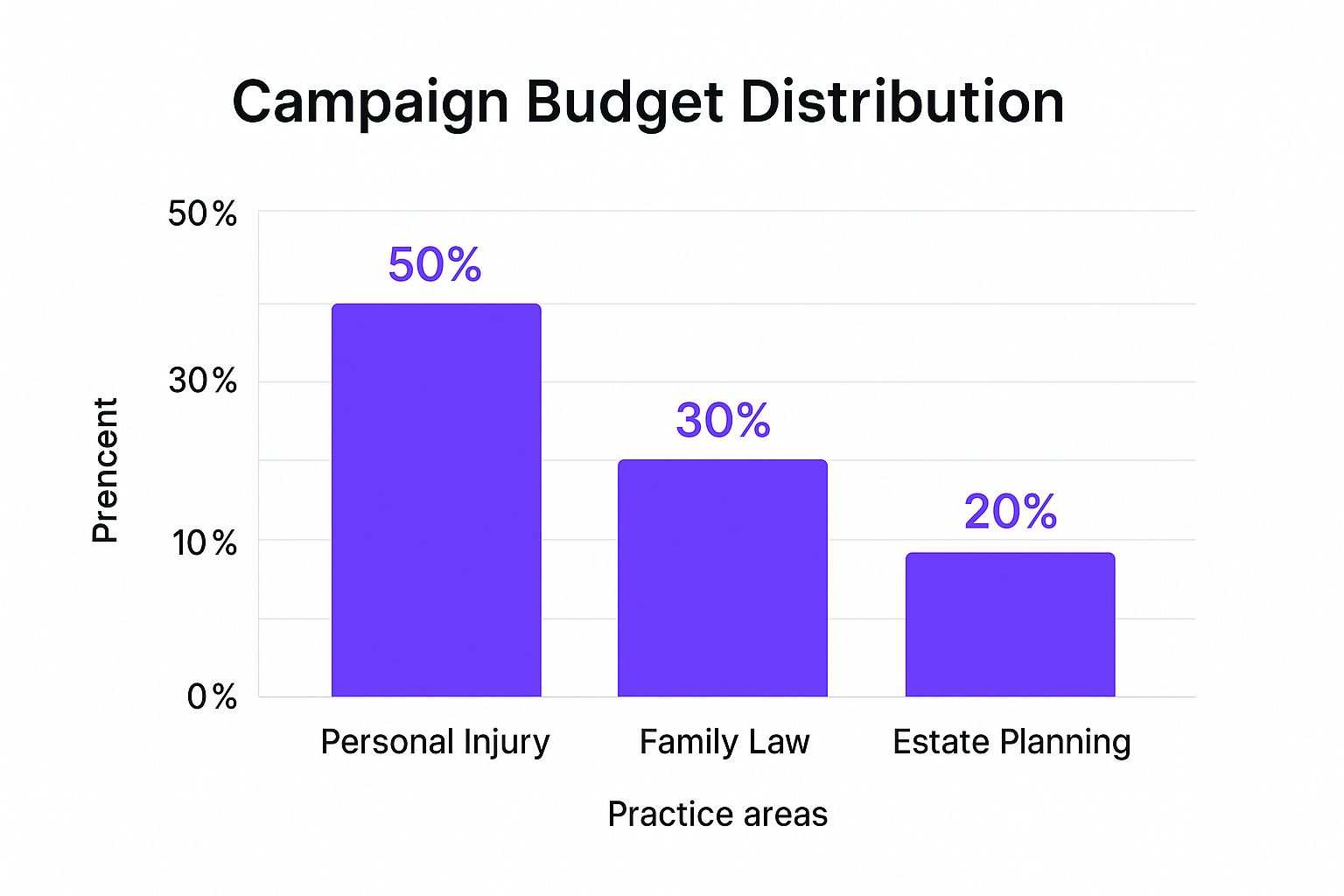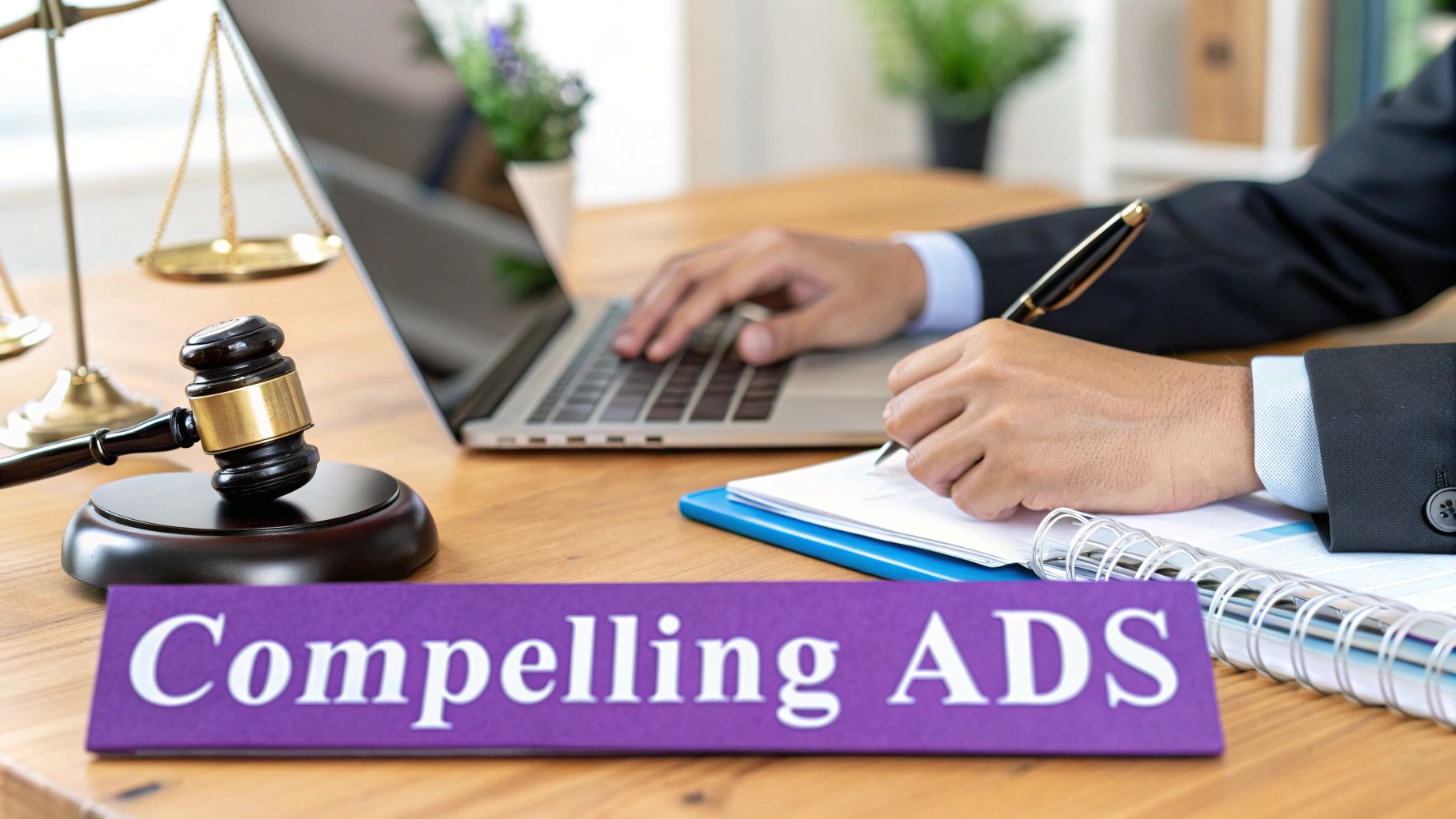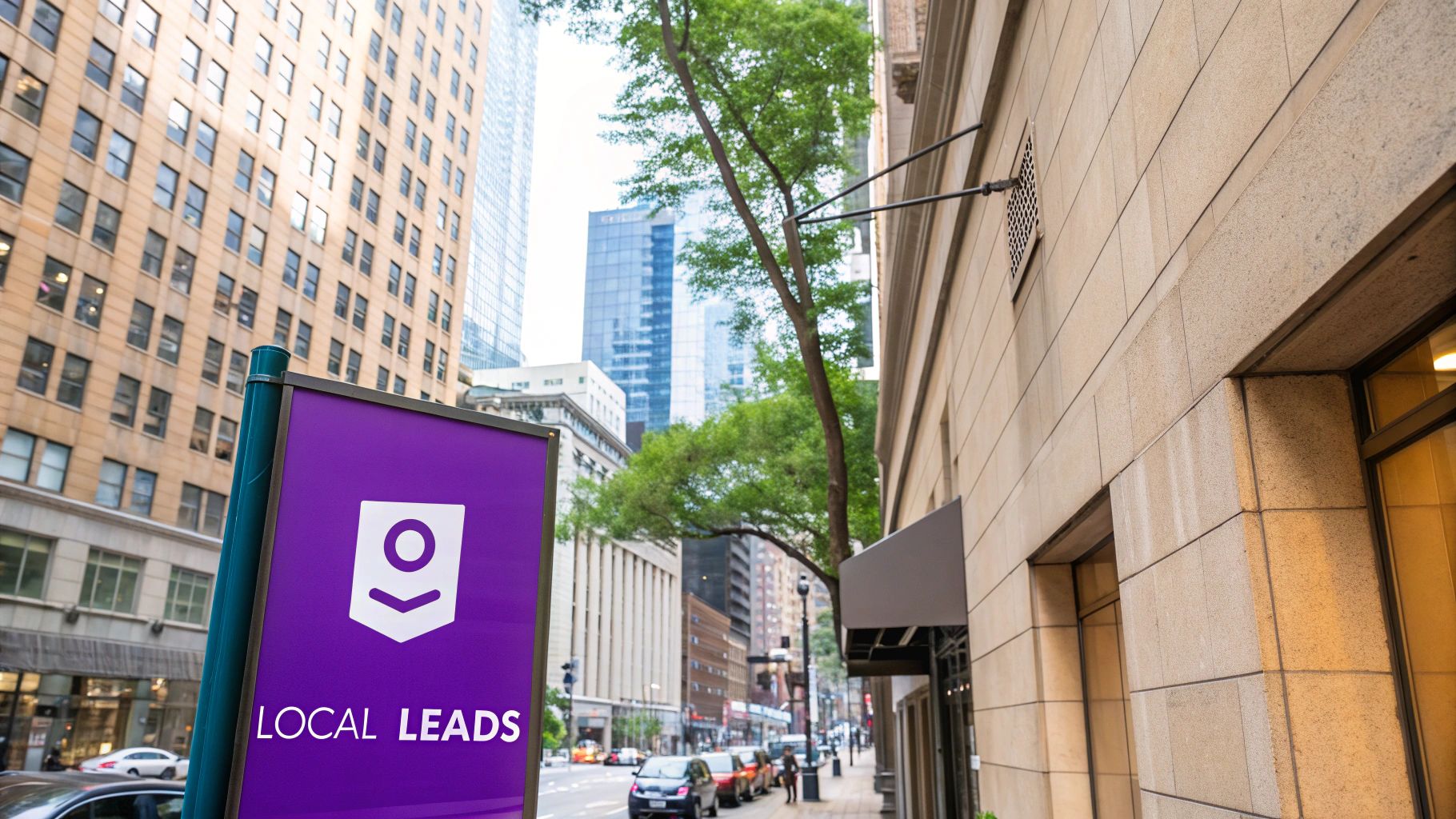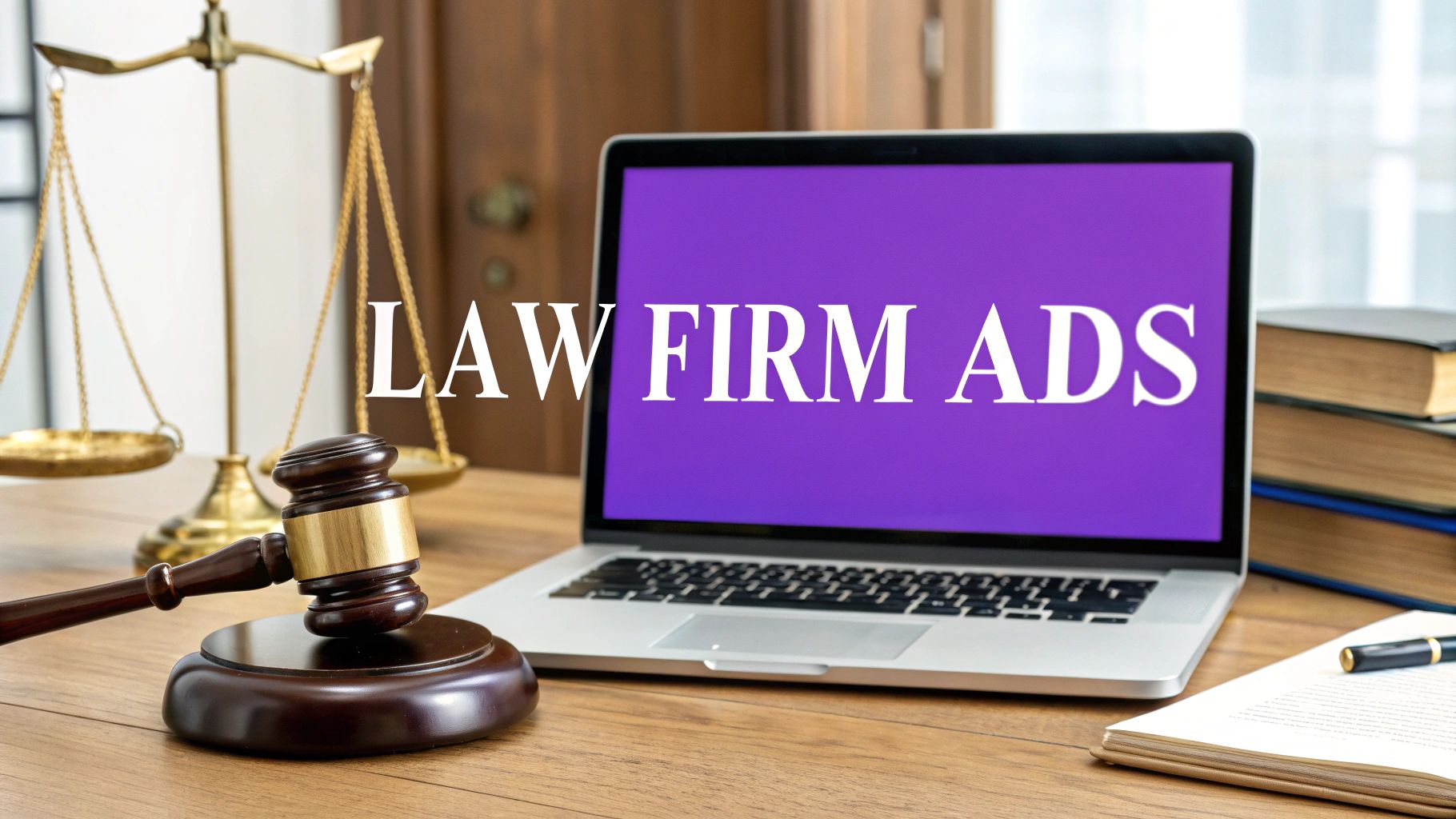Google Ads for Law Firms A Practical Guide
Think your law firm can thrive on referrals and a slick website alone? Think again.
If you’re waiting for organic SEO to kick in, you're letting potential clients slip through your fingers right now. Someone is searching for a lawyer at this very moment, and if you’re not at the top of Google, you're invisible.
This is where Google Ads comes in. It's not just another line item in your marketing budget; it's a pay-per-click (PPC) platform that puts your firm front and center the instant a client is looking for legal help. We're talking about capturing high-intent leads who are ready to make a call, not just browse.
Why Google Ads Are Essential for Law Firm Growth

Let's cut to the chase. The real magic of Google Ads for law firms is its speed and precision. While a solid SEO strategy is your long-term marathon, Google Ads is the all-out sprint. Within minutes of launching a campaign, your firm can be the first thing someone sees when they type "personal injury lawyer near me."
This immediacy is a total game-changer in the legal world. A client's need is almost always urgent and time-sensitive. You aren't just putting your name on a billboard and hoping for the best; you're directly answering a call for help at the exact moment it’s made.
The Strategic Advantage Over Traditional Methods
For decades, law firms ran on referrals and word-of-mouth. Those are still gold, but they're passive. Google Ads, on the other hand, is an active client acquisition machine. Its power lies in its almost scary-specific targeting. You can aim your budget with laser focus:
- Specific Practice Areas: Want more high-value commercial litigation cases? Funnel your ad spend there.
- Geographic Locations: Target clients down to the zip code, ensuring you only pay for clicks from people you can actually represent.
- Client Demographics: Reach individuals based on age, income, or other factors crucial for practice areas like estate planning.
This isn’t just spending money on marketing; it’s making a direct investment into your case pipeline. The secret is out, too. By 2025, an estimated 23% of lawyers are expected to be using Google Ads to land new clients, marking a huge shift away from purely old-school marketing.
Building a Foundation for Success
Before you even think about launching an ad, you need to get your house in order. A brilliant ad that leads to a website with a handful of 2-star reviews is a complete waste of money. You have to nail your digital first impression.
Strengthening your firm's online presence with effective online reputation management for lawyers is a non-negotiable first step. Your reviews, your website, your social proof—it all has to be solid.
A well-managed Google Ads account does more than generate clicks; it creates a predictable and scalable stream of qualified leads, turning your marketing spend into a reliable engine for firm growth.
Ultimately, Google Ads hands you the data to make smarter business decisions. You'll see exactly which keywords, ad copy, and targeting strategies are driving the cases that matter most. To build a truly dominant client acquisition system, this approach needs to be woven into a broader set of proven law firm marketing strategies.
Structuring Your Campaigns for Maximum Impact
Let’s be real: a disorganized Google Ads account is a money pit. It feels like a messy filing cabinet where finding what you need is impossible, and everything costs you more time and cash than it should. The absolute foundation of a winning Google Ads strategy for any law firm is a clean, logical campaign structure. This isn't just about being neat—it's about control, relevance, and, ultimately, profitability.
The most common mistake I see firms make is cramming all their services into one giant, unwieldy campaign. Think about it. A potential client frantically searching for a "divorce lawyer" has completely different needs, emotions, and search terms than someone looking for a "car accident attorney." A single, generic ad campaign can't possibly speak to both effectively. It just can't.
The Power of Practice Area Campaigns
The smartest way to structure your account is to create separate campaigns for each distinct practice area you serve. This simple move unlocks some seriously powerful benefits:
- Total Budget Control: You can finally allocate your ad spend with surgical precision. Want to push your most profitable practice area, like Personal Injury? Give it a bigger slice of the budget while dedicating smaller amounts to others.
- Laser-Focused Messaging: This allows you to craft ad copy and landing pages that speak directly to the specific fears and needs of a potential client for that exact practice area.
- Sky-High Relevance: Google's algorithm rewards relevance. Big time. When your keywords, ads, and landing pages are all tightly aligned, your Quality Score goes up, which often leads to lower click costs and better ad positions. It’s a win-win.
For any multi-practice firm, the campaign structure should look something like this. Clean, simple, and effective.
- Campaign 1: Personal Injury
- Campaign 2: Family Law
- Campaign 3: Estate Planning
- Campaign 4: Criminal Defense
This clear separation is your first step in turning a vague ad spend into a calculated, high-return investment. To see how top performers put this into practice, it's worth checking out some top Google Ads examples and tips to spark ideas for your own strategy.
Here’s a quick visual of how a firm might strategically split its budget across these distinct campaigns.

You can see the strategic focus right away. The budget follows the business priorities, putting the most fuel into the highest-value practice area.
Drilling Down with Tightly-Themed Ad Groups
Now, inside each of those practice area campaigns, we get even more granular with ad groups. Think of an ad group as a sub-folder for a specific service or case type. This is where you achieve hyper-relevance.
For example, inside your "Personal Injury" campaign, you wouldn't just have one ad group. No way. You'd break it down into several, each focused on a very specific keyword theme:
- Ad Group: Car Accident Lawyers
- Ad Group: Truck Accident Attorneys
- Ad Group: Slip and Fall Lawyers
- Ad Group: Motorcycle Injury Attorneys
This level of detail means you can write an ad for someone searching "truck accident attorney" that specifically mentions trucking regulations and commercial insurance policies. That ad is infinitely more likely to get a click than a generic "Personal Injury Lawyer" ad. It shows you get their problem.
A well-structured account allows you to mirror a potential client's thought process. You meet them with the exact language they used in their search, building immediate trust and demonstrating that you understand their specific problem.
Targeting Your Ideal Clients Geographically
One of the most powerful tools in the Google Ads arsenal for law firms is geographic targeting. You absolutely do not want to waste your budget on clicks from people outside your jurisdiction.
Don't just target your state or city. Get granular.
- Target by County: Zero in on the counties you serve most often.
- Target by ZIP Code: Focus your budget on more affluent neighborhoods or areas where your ideal clients live.
- Use Radius Targeting: Show ads only to users within, say, a 20-mile radius of your office.
This kind of precision ensures your ads are only being seen by potential clients you can actually represent, which drastically improves the quality of your leads. When you combine practice-area campaigns, themed ad groups, and sharp geographic targeting, you create a powerful structure that makes every single dollar you spend work harder for you.
Finding Keywords That Attract Ready-to-Hire Clients
This is where the magic happens. A killer Google Ads campaign for a law firm isn’t about flashy design or a massive budget—it’s built on finding the exact search terms people use when they desperately need a lawyer and are ready to pick up the phone.
Forget guessing. You have to climb inside the head of a potential client who's stressed, confused, and probably typing into Google at 2 a.m. Your entire strategy hinges on a single, powerful concept: search intent.
https://www.youtube.com/embed/13LSSmNwp7I
Think about it. No one just wakes up and searches for "motorcycle accident attorney." Their journey likely starts with something much broader, like "what to do after a bike crash" or "how to get the police report." Your job is to show up the second their search shifts from research to action.
High-Value vs. Low-Value Keywords: Don't Burn Your Budget
Not all clicks are created equal. In the legal world, keywords generally fall into two camps, and confusing them is the fastest way to drain your bank account.
- Informational Keywords: These are your "what is," "how to," and "why" searches. Think: "what is negligence" or "statute of limitations for car accidents." The person searching is looking for free information, not a retainer agreement. Great for an SEO blog post, but an absolute money pit for your ad campaigns.
- Transactional Keywords: This is your bread and butter. Searches like "personal injury lawyer near me" or "hire divorce attorney in Dallas" are screaming with intent. These people have a problem, and they're looking to pay someone to solve it. Yes, these keywords are more expensive and competitive, but they deliver actual leads.
The single biggest mistake a firm can make is spending its ad budget on informational keywords. You’re paying a premium for clicks from people who are just looking for free answers, not for legal representation. Focus your spend on transactional, "ready-to-hire" terms.
Making this distinction is the first filter for every keyword you even consider. By zeroing in on transactional intent, you’re basically pre-qualifying your audience before they even see your ad.
This table breaks down how to think about the keywords you'll come across and where they fit into your strategy.
Legal Keyword Intent Analysis
| Broad Informational | "car accident laws" | Researching general legal concepts. | Very Low. Avoid for paid ads. |
|---|---|---|---|
| Specific Informational | "whiplash symptoms after crash" | Trying to understand their situation. | Low. Better for blog content (SEO). |
| Navigational | "John Doe Law Firm website" | Looking for a specific, known firm. | High (for brand campaigns). |
| High-Intent Transactional | "hire car accident lawyer Houston" | Ready to hire. Actively seeking representation. | Very High. This is the gold mine. |
| Long-Tail Transactional | "truck accident lawyer for 18-wheeler rollover" | Has a specific, high-value case. | Extremely High. Lower volume but high quality. |
Ultimately, your goal is to live in the "Transactional" columns, as these are the searches that turn into signed cases.
Uncovering the Goldmine of Long-Tail Keywords
Everyone and their brother is bidding on "car accident lawyer." It’s essential, sure, but it’s also a battlefield with a sky-high cost-per-click (CPC). The real competitive advantage often comes from long-tail keywords.
These are longer, more specific search phrases. They have less search volume, but they convert like crazy.
A person searching for "lawyer" is just browsing. But a person searching for "best truck accident lawyer for commercial vehicle collision"? That person has a very specific, high-value problem they need solved right now.
Here’s how you start finding them:
- Get Hyper-Local: Instead of "family law attorney," target "family law attorney in Bergen County NJ."
- Drill Down on Case Type: Don't just bid on "DUI lawyer." Go for "first offense DUI lawyer consultation."
- Look for Action Words: Keywords that include terms like "hire," "find," or "consultation" are clear signals of commercial intent.
These long-tail gems are less competitive, which means your CPC is often much lower. Better yet, their specificity means the person clicking your ad is a far more qualified—and valuable—potential client.
Build a Bulletproof Negative Keyword List (Your Campaign's Shield)
Choosing what to bid on is only half the battle. Just as critical is telling Google what not to bid on. Your negative keyword list is the shield that protects your budget from being wasted on irrelevant searches. This isn’t an optional tweak; it’s a financial necessity.
Start building this list from day one and never stop adding to it. Kick things off with the obvious terms that attract the wrong clicks for pretty much any law firm:
- free
- pro bono
- jobs
- salary
- paralegal
- internship
- school
- books
By adding these as negative keywords, you’re telling Google, "If a search includes any of these words, do not show my ad." It’s one of the simplest, highest-impact optimizations you can make, and it can save you thousands of dollars by filtering out students, job seekers, and people who will never become paying clients.
Writing Ad Copy That Converts and Complies

This is where the rubber meets the road. Crafting compelling ad copy for your law firm is a delicate dance between persuasion and professional responsibility. You’re not just selling a service; you’re offering a lifeline to someone neck-deep in a stressful, life-altering situation.
The language you use has to build instant trust and convey authority, all while navigating a minefield of state bar association advertising rules. Generic, corporate-sounding ads get ignored. Your copy needs to speak directly to the searcher's pain point and position your firm as the obvious solution.
Mastering Headlines That Command Attention
Your headline is your digital handshake. You’ve got about three seconds to grab a user’s attention and convince them your ad is the best answer to their urgent problem.
Forget clever wordplay; clarity and direct benefits win every time.
Focus on headlines that resonate with a user's immediate fears and goals. For a personal injury campaign, ditch the generic "Experienced Law Firm" and test headlines that offer a tangible benefit or a powerful assurance.
- Weak Headline: Smith & Jones Law Firm
- Strong Headline: No Win, No Fee Guarantee
- Weak Headline: We Handle Car Accidents
- Strong Headline: Max Compensation For Your Injuries
See the difference? The stronger examples work because they address the client's biggest concerns head-on: financial risk and the desired outcome. The goal is to make them think, "This firm gets what I need right now."
Writing Descriptions That Build Trust and Drive Action
Once the headline hooks them, the description copy reels them in. This is where you quickly make the case for why your firm is the right choice. Use this tiny space to highlight what makes you different and give a clear, compelling call-to-action (CTA).
Instead of just listing services, frame them as client-focused benefits.
- Highlight unique selling points: Mentioning "24/7 Availability" or "Bilingual Staff" can be a massive differentiator that addresses a client's immediate need for accessibility and support.
- Create a sense of urgency (ethically): Phrases like "Strict Deadlines Apply" or "Protect Your Rights Today" encourage immediate action without making wild, unsubstantiated promises.
- Use a powerful call-to-action: "Contact Us" is passive and weak. "Call for a Free & Confidential Case Evaluation" is an invitation. It removes the two biggest barriers: cost and privacy concerns.
Your ad copy should function as a bridge, connecting a person's urgent legal problem directly to your firm's specific solution. Every word must work toward building that connection by conveying empathy, authority, and a clear path forward.
Supercharging Your Ads with Extensions
Ad extensions are the secret weapon of high-performing Google Ads for law firms. Think of them as extra snippets of information that expand your ad's physical size, making it more prominent and giving users more reasons to click.
Using them isn't just a best practice; it's essential for competing in the crowded legal market. A few are absolutely non-negotiable for attorneys.
Must-Have Ad Extensions for Law Firms
Sitelink Extensions: These are bonus links that appear below your main ad, pointing users to specific pages on your site. Instead of just dumping everyone on your homepage, you can guide them directly to your "Car Accidents" practice page, "Client Testimonials," or your "Our Attorneys" page. It’s a better user experience and shows you have deep, relevant content.
Call Extensions: This is an absolute must-have for mobile users. A call extension slaps your phone number right onto the ad, letting a potential client call your office with a single tap. In an urgent legal situation, removing the friction of having to visit a website first can be the difference between getting the call or losing it to a competitor.
Location Extensions: For firms that depend on local clients, this extension is gold. It displays your address, a map to your office, and your business hours. It's a powerful signal of local authority and makes it incredibly easy for nearby clients to find you.
By using these extensions strategically, you don’t just take up more screen real estate—you give a potential client multiple, frictionless ways to get in touch with your firm.
Fine-Tuning Your Bids and Building Landing Pages That Convert
Getting a potential client to click your ad is a huge win, but it's only half the battle. The moment they hit your website, the real work begins. This is where you grab the financial controls of your campaign and create a landing page experience that turns an interested clicker into a qualified lead for your firm.
The legal field is a gladiator pit of competition, which means one thing: expensive clicks. Because of this, your bidding strategy and budget aren't just details to figure out later—they're the very core of whether your campaign makes money or loses it. You have to decide how much you want to micromanage and how much you trust Google's machine learning to do the heavy lifting.
Picking the Right Bidding Strategy
Your bidding strategy is basically your instruction manual for Google on how to spend your cash. For law firms, it usually comes down to two main philosophies.
- Manual CPC (Cost-Per-Click): This puts you in the driver's seat. You set the absolute maximum you’re willing to pay for a single click on any given keyword. It’s the perfect strategy for a brand-new campaign where you're still gathering data and need to protect a tight budget from getting torched. For instance, you could cap your bid at $75 for "car accident lawyer" to make sure you never overpay while testing the waters.
- Automated Bidding: Strategies like Maximize Conversions or Target CPA (Cost Per Acquisition) let Google’s AI adjust your bids on the fly. These are incredibly powerful once you have a solid history of conversion data. Maximize Conversions, for example, tells Google to get you the most leads possible within your daily budget—a fantastic choice for firms laser-focused on lead volume.
Here’s a pro tip: Start any new campaign on Manual CPC to set a performance baseline and see what's what. Once you’re consistently getting at least 15-20 conversions a month, you can flip the switch to an automated strategy like Maximize Conversions and let the algorithm take over to find efficiencies you couldn't spot on your own.
Setting Budgets That Actually Drive Growth
Think of your daily budget as your campaign's financial safety net. A smart way to set it is to work backward from your business goals.
Let's say a signed case is worth $10,000 to your firm, and you know you can close one out of every ten qualified leads. That means you can afford to pay up to $1,000 per lead and still be profitable. Thinking this way anchors your ad spend directly to real business outcomes. To get a better handle on these numbers, you can model different scenarios with tools like a specialized Google Ads calculator for law firms.
This context is everything, especially when you look at industry averages. The average click-through rate (CTR) for legal services on Google Ads was around 5.97% in 2025. And the cost per lead? It's one of the highest out there, averaging $131.63. These figures can seem intimidating, but law firms keep investing heavily for a simple reason: the platform delivers high-value leads that turn into high-value cases. You can explore more of the latest numbers in the 2025 Google Ads benchmarks on Wordstream.com.
Designing a Legal Landing Page That Closes the Deal
Your ad makes a promise. Your landing page better deliver on it.
Sending someone who clicked an ad for a "DUI defense lawyer" to your generic firm homepage is a guaranteed way to waste ad spend. They'll get confused, hit the back button, and you'll have paid for nothing. Every single ad campaign needs its own dedicated landing page built for one thing and one thing only: conversion.
Here are the absolute must-haves:
A Headline That Delivers on the Promise: The headline has to instantly tell the user, "Yes, you're in the right place." It should echo the ad's message and speak directly to their pain point.
- Weak: Smith & Associates Law
- Strong: Get Maximum Compensation for Your Florida Car Accident Injury
Social Proof That Screams "Trustworthy": Someone facing a legal crisis is desperate for signals they can trust you. Plaster your page with case results, glowing client testimonials, and attorney awards. Seeing proof that you've successfully helped people in their exact situation is a massive relief.
An Obvious, Unmistakable Call-to-Action: Don't make people search for how to contact you. Use a big, bold contact form and place it "above the fold" (where it's visible without scrolling). And keep that form dead simple—all you need is their name, email, phone number, and a small box for their message. Anything more just creates friction.
Winning Local Clients with Local Service Ads

If your law firm is hunting for high-intent clients right in your backyard, you need to be paying attention to Google’s Local Service Ads (LSAs). These aren't your standard search ads. They sit at the very top of the search results—even above the traditional pay-per-click ads—making them the most valuable real estate for grabbing a client’s attention.
The real magic here is the pay-per-lead model. Forget paying every time someone clicks on your ad. With LSAs, you only pay when a potential client actually calls or messages your firm through the ad. It’s a completely different ballgame, focusing your budget on real inquiries and cutting out the wasted spend on casual browsers.
Earning the Google Screened Badge
The entire LSA program is built on a foundation of trust. Before you can even get in the game, your firm has to go through a pretty rigorous verification process. We're talking background checks, license verifications, and a thorough vetting by Google itself. Pass the test, and you earn the coveted "Google Screened" badge.
This little green checkmark is a massive signal of credibility. In an instant, it tells potential clients that Google has done its homework on your firm. For a field like law where trust is everything, that badge can be the single factor that pushes a client to call you instead of the competition.
How to Dominate Your Local Market with LSAs
Just getting screened isn't enough to win. To really maximize your visibility and get the phone ringing, you have to actively manage your LSA profile. It's not a set-it-and-forget-it tool.
Here’s what truly moves the needle:
- Speed is Everything: Your responsiveness is a huge ranking factor. You absolutely must answer calls and reply to messages as quickly as possible.
- Reviews are Your Reputation: Consistently getting new, positive reviews on your LSA profile is what will make you stand out from other screened firms.
- Fill Out Your Profile: A complete profile with high-quality photos, clearly defined service areas, and accurate business hours will always outperform a sparse one.
Think about it: statistics show that 78% of people who look up local services on their phone end up visiting a business within 24 hours. That's the kind of immediate action LSAs are built to capture. If you want a deeper look, Attorney at Work has some great insights on how Google Local Service Ads are working for law firms.
Don't think of LSAs as a replacement for your other search campaigns. They're a powerful complement. These ads are specifically designed to catch clients who are done with their research and ready to hire someone now. That makes them indispensable for any firm serious about local growth.
Running these ads effectively demands a hyperlocal mindset, which goes hand-in-hand with a strong local SEO game. To really dial in your strategy, take a look at our complete local SEO checklist for more actionable tactics.
Common Questions We Hear About Google Ads for Law Firms
Look, attorneys usually come to us with a mix of excitement and a healthy dose of skepticism about Google Ads. That’s smart. Before you invest a single dollar, you need to understand the real financial and time commitments involved.
Let’s tackle the big questions we get asked all the time.
How Much Should My Law Firm Actually Spend on Google Ads?
There’s no magic number here. Anyone who tells you otherwise is selling something. Your budget is going to hinge on your practice area, how cutthroat your local market is, and how fast you’re trying to grow.
To give you a real-world idea, a personal injury firm fighting for space in a major city like Los Angeles might need to invest upwards of $20,000 a month just to stay competitive. The clicks there are insanely expensive.
But it's not always like that. A family lawyer in a smaller town could see fantastic results with a budget between $2,000 and $5,000. The best way to start? Pick one high-value practice area, set a focused test budget, and prove it works. Once you can track your cost per signed case and see a positive return, then you can scale up.
How Long Until I Start Seeing Results?
This is where Google Ads really shines. Unlike SEO, which is a long, slow climb, Google Ads can have your phone ringing within days—sometimes hours—of launching a campaign. That immediate visibility is a huge advantage.
But let's be clear: getting traffic is not the same as getting a predictable return on your investment. The first 1-3 months are all about gathering data and optimizing. Think of it as a learning phase. You'll be fine-tuning keywords, testing ad copy, and tweaking bids to figure out exactly what makes your ideal clients click. Peak performance doesn't happen overnight.
Should I Run Google Ads Myself or Hire an Agency?
It's tempting to think you can manage this in-house, and technically, you can. But the legal advertising world on Google is a battlefield. It’s fiercely competitive and incredibly unforgiving.
With click costs often soaring past $100, one little mistake—a wrong keyword match type, a poorly worded ad—can burn through your budget with nothing to show for it.
If you don't have at least 5-10 hours a week to dedicate to actively managing campaigns and staying on top of Google's constant changes, hiring a specialized legal marketing agency is almost always the smarter financial decision. They already know the compliance rules and have proven strategies to start generating high-quality cases from day one.
Ready to stop guessing and start getting real results from your advertising? The expert team at Rebus has managed over $100 million in ad spend, helping law firms like yours build predictable client acquisition systems. Partner with us to supercharge your marketing and drive sustainable growth. Let's talk about your firm's growth.
